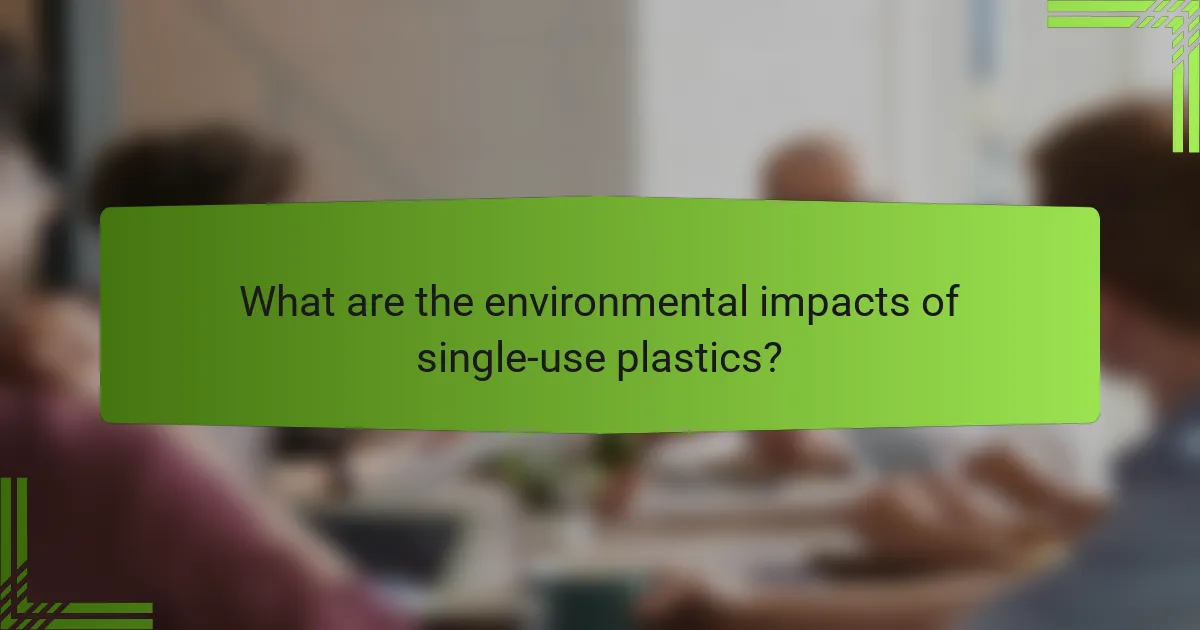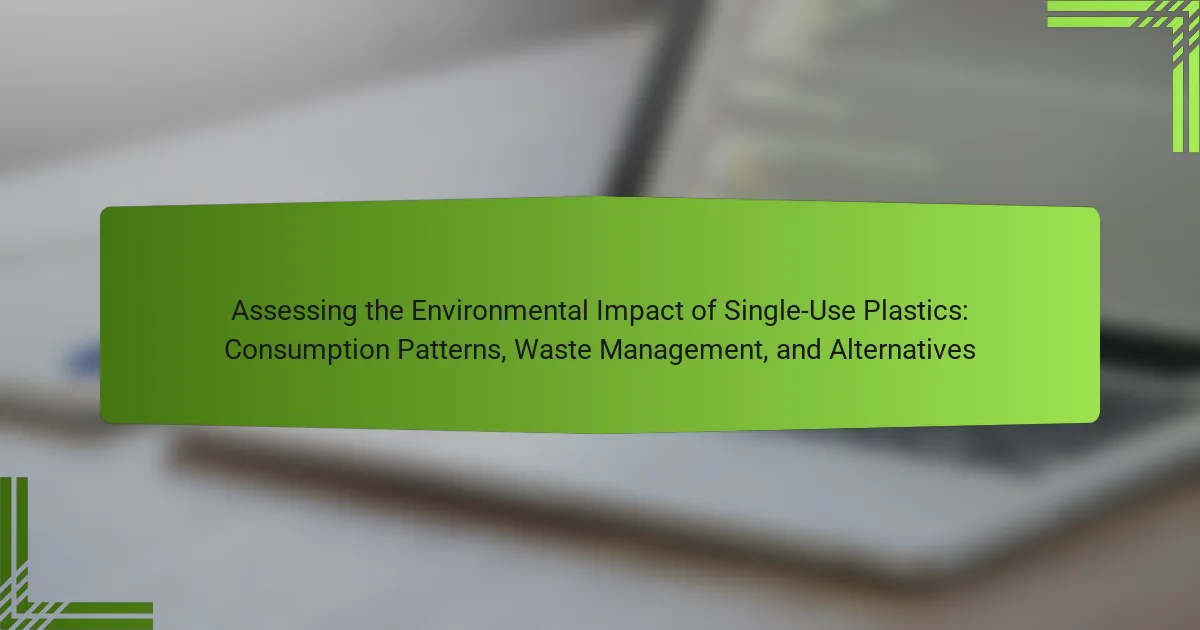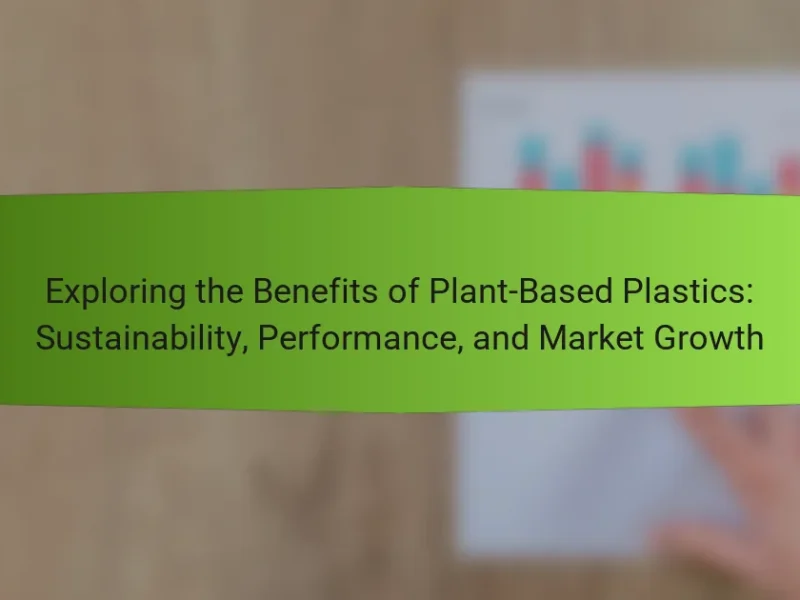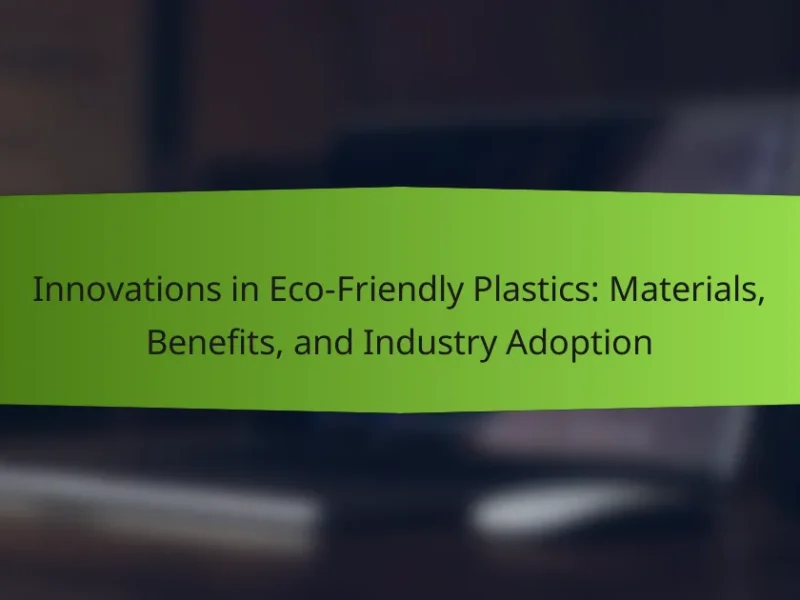Single-use plastics are a significant environmental concern due to their contribution to pollution in oceans and landfills, with around 300 million tons produced annually. These plastics take centuries to decompose, causing harm to marine life and disrupting ecosystems. Consumption patterns reveal that convenience and low cost drive the high use of single-use plastics, particularly in food service. Waste management strategies are evolving, with municipalities implementing regulations and enhancing recycling programs, yet only 9% of plastic waste is currently recycled in the U.S. Alternatives such as biodegradable materials and reusable products present viable solutions to reduce reliance on single-use plastics and mitigate their environmental impact.

What are the environmental impacts of single-use plastics?
Single-use plastics significantly harm the environment. They contribute to pollution in oceans and landfills. Approximately 300 million tons of plastic are produced annually, with a large portion being single-use. These plastics take hundreds of years to decompose. Marine life often ingests plastic debris, leading to injury or death. Additionally, the production process emits greenhouse gases, contributing to climate change. The accumulation of plastics disrupts ecosystems and harms biodiversity. Effective waste management strategies are often lacking, exacerbating these impacts.
How do single-use plastics contribute to pollution?
Single-use plastics contribute to pollution by creating substantial waste that often ends up in landfills and oceans. These plastics are designed for short-term use and are discarded after one use. According to the United Nations, approximately 300 million tons of plastic waste are generated annually. A significant portion of this waste is single-use, including items like bags, straws, and bottles.
When discarded, single-use plastics can take hundreds of years to decompose. This slow degradation process allows plastics to break down into smaller microplastics, which can contaminate soil and waterways. Research indicates that microplastics have been found in marine life and even in human food sources.
Additionally, the production of single-use plastics involves fossil fuels, contributing to greenhouse gas emissions. The environmental impact of these emissions further exacerbates climate change issues. Thus, single-use plastics significantly contribute to pollution through waste generation, long decomposition times, and associated greenhouse gas emissions.
What types of pollution are most associated with single-use plastics?
Single-use plastics are most associated with marine pollution, land pollution, and air pollution. Marine pollution occurs when plastics enter oceans, harming marine life. Reports indicate that over 800 species are affected by marine debris, primarily plastic. Land pollution arises from improper disposal and littering, leading to soil contamination. Statistics show that approximately 9 million tons of plastic waste end up in landfills annually. Air pollution is linked to the incineration of single-use plastics, releasing harmful toxins into the atmosphere. Studies reveal that burning plastics can emit dioxins, which are hazardous to human health.
How does plastic waste affect marine and terrestrial ecosystems?
Plastic waste significantly harms marine and terrestrial ecosystems. In marine environments, plastic debris entangles marine animals and is ingested by various species. This ingestion can lead to malnutrition, starvation, and death. Research shows that over 800 species are affected by marine debris, including fish, birds, and mammals. In terrestrial ecosystems, plastic pollution disrupts soil health and affects plant growth. Microplastics can leach harmful chemicals into the soil, impacting soil organisms and food chains. Studies indicate that plastic waste can take hundreds of years to decompose, leading to long-term ecological consequences. The accumulation of plastics in both ecosystems poses a serious threat to biodiversity and ecosystem stability.
Why is it important to assess the environmental impact of single-use plastics?
Assessing the environmental impact of single-use plastics is crucial for understanding their effects on ecosystems. Single-use plastics contribute significantly to pollution and waste accumulation. According to the United Nations, approximately 300 million tons of plastic are produced annually, with a large portion being single-use. These plastics can take hundreds of years to decompose, leading to long-term environmental consequences. Evaluating their impact helps identify sources of pollution and informs policy decisions. It also aids in developing sustainable alternatives and improving waste management practices. Ultimately, this assessment is vital for protecting biodiversity and promoting environmental health.
What are the long-term consequences of plastic pollution?
Plastic pollution leads to significant long-term environmental consequences. It disrupts marine ecosystems, harming wildlife through ingestion and entanglement. Microplastics, which result from the breakdown of larger plastic items, contaminate water sources and enter the food chain. Research indicates that over 1 million marine creatures die each year due to plastic pollution. Additionally, plastic waste contributes to habitat destruction, particularly in coastal areas. The persistence of plastics in the environment can last hundreds of years, leading to ongoing ecological damage. Furthermore, the presence of plastics in soil affects agricultural productivity by altering soil structure and nutrient availability. These consequences highlight the urgent need for effective waste management and reduction strategies.
How does plastic waste management influence environmental health?
Plastic waste management significantly influences environmental health by reducing pollution and minimizing ecosystem damage. Effective management practices decrease the amount of plastic that ends up in landfills and oceans. According to the United Nations, approximately 8 million tons of plastic enter oceans annually, harming marine life. Proper recycling and waste reduction can prevent toxic substances from leaching into soil and water. Research shows that plastics can release harmful chemicals during degradation, impacting both wildlife and human health. By implementing better waste management strategies, communities can enhance air and water quality. This leads to healthier ecosystems and improved public health outcomes.

What consumption patterns are associated with single-use plastics?
Consumption patterns associated with single-use plastics include high-frequency use, convenience-driven choices, and low-cost preferences. Consumers often select single-use plastics for their portability and ease of access. This behavior is evident in fast-food packaging, disposable cutlery, and plastic bags. A significant portion of single-use plastics is used in food service, with studies indicating that over 300 million tons are produced annually. Additionally, the availability of single-use plastics influences consumer habits, leading to increased reliance on these products. Research shows that convenience often outweighs environmental considerations in purchasing decisions. As a result, single-use plastics contribute substantially to global plastic waste, with an estimated 50% of produced plastics being disposable.
How do consumer behaviors impact single-use plastic usage?
Consumer behaviors significantly influence single-use plastic usage. Increased demand for convenience drives higher consumption of single-use plastics. Many consumers prefer products that are easy to use and dispose of. This preference leads to a rise in plastic packaging and disposable items. Studies show that 50% of plastic waste comes from consumer goods packaging. Awareness of environmental issues can alter behaviors. Consumers increasingly seek sustainable alternatives, reducing single-use plastic reliance. For instance, a survey revealed that 70% of consumers support bans on plastic straws. Such shifts in behavior can lead to a decrease in single-use plastic usage.
What demographic factors influence the consumption of single-use plastics?
Age, income, education level, and geographic location influence the consumption of single-use plastics. Younger individuals tend to use more single-use plastics compared to older generations. Higher income levels often correlate with increased consumption due to greater access to convenience products. Education plays a role, as individuals with higher education levels may be more aware of environmental issues and thus consume less. Geographic location affects availability and cultural attitudes toward single-use plastics. Urban areas typically exhibit higher consumption rates due to convenience, while rural areas may have less access to alternatives. Research shows that demographic trends significantly impact plastic usage patterns.
How do cultural attitudes shape the demand for single-use plastics?
Cultural attitudes significantly influence the demand for single-use plastics. Societies that prioritize convenience often exhibit higher consumption rates of these products. In contrast, cultures that emphasize sustainability tend to reduce reliance on single-use plastics. For instance, in countries like Japan, cultural norms around cleanliness and efficiency drive the use of plastic packaging. Conversely, in regions with strong environmental movements, such as Scandinavia, there is a push for alternatives to single-use plastics. Research shows that public perception and social norms directly affect consumer behavior. A study by the Pew Charitable Trusts found that awareness campaigns can shift attitudes and reduce plastic use. Therefore, cultural attitudes play a crucial role in shaping consumption patterns of single-use plastics.
What are the most common types of single-use plastics consumed?
The most common types of single-use plastics consumed include plastic bags, straws, cutlery, plates, and food containers. Plastic bags are frequently used for shopping and carryout. Straws are commonly found in beverages at restaurants and fast food outlets. Single-use cutlery and plates are often utilized at parties and picnics. Food containers are widely used for takeout and meal prep. According to the United Nations Environment Programme, these items contribute significantly to plastic waste globally.
Which industries are the largest contributors to single-use plastic consumption?
The largest contributors to single-use plastic consumption are the packaging, food service, and retail industries. The packaging industry accounts for approximately 40% of global plastic use. This includes materials such as plastic bags, wrappers, and containers. The food service industry, including restaurants and takeout services, significantly contributes through disposable cutlery and food containers. Retailers also play a major role, particularly through plastic bags and product packaging. According to the Ellen MacArthur Foundation, over 300 million tons of plastic are produced annually, with a substantial portion being single-use. This data underscores the critical need for alternatives and better waste management practices.
What products are most frequently disposed of as single-use plastics?
Common products disposed of as single-use plastics include plastic bags, straws, cutlery, plates, and food containers. Plastic bags are widely used for shopping and are often discarded after a single use. Straws are frequently provided with beverages and are typically thrown away immediately after use. Plastic cutlery and plates are commonly used for takeout meals and events, leading to high disposal rates. Food containers, such as takeout boxes and plastic wrap, are also disposed of after one use. According to the United Nations Environment Programme, these items contribute significantly to global plastic waste.

How is waste management addressing single-use plastics?
Waste management is addressing single-use plastics through enhanced recycling programs and reduction initiatives. Many municipalities are implementing stricter regulations on single-use plastics. These regulations often include bans on plastic bags and straws. Additionally, waste management systems are investing in advanced recycling technologies. These technologies improve the efficiency of processing plastic waste. According to the Environmental Protection Agency, only 9% of plastic waste is recycled in the U.S. This statistic highlights the need for better waste management solutions. Public awareness campaigns are also being launched to educate consumers. These campaigns encourage the reduction of single-use plastic consumption.
What methods are used in the waste management of single-use plastics?
Methods used in the waste management of single-use plastics include recycling, incineration, and landfill disposal. Recycling involves collecting and processing plastic materials to create new products. According to the Environmental Protection Agency, in 2018, only 9% of plastic waste was recycled in the U.S. Incineration converts plastic waste into energy, reducing the volume and potential environmental harm. However, it can release harmful emissions if not properly managed. Landfill disposal is the most common method, where plastics are buried, but this leads to long-term environmental issues, as plastics can take hundreds of years to decompose. Additionally, some regions are implementing composting for biodegradable plastics. Each method carries its own environmental impact and efficiency challenges.
How effective are recycling programs for single-use plastics?
Recycling programs for single-use plastics are generally ineffective. Only about 9% of plastic waste is recycled globally. Most single-use plastics are not collected or processed properly. Contamination during collection reduces recycling rates. Many recycling facilities are not equipped to handle certain types of plastics. This results in a significant amount of single-use plastics ending up in landfills and oceans. The lack of consumer awareness also hinders recycling efforts. According to the Environmental Protection Agency, effective recycling requires proper sorting and public participation.
What challenges do waste management systems face with plastic waste?
Waste management systems face significant challenges with plastic waste. The sheer volume of plastic waste generated is overwhelming. In 2019, the world produced approximately 368 million metric tons of plastic. Many plastics are not biodegradable, persisting in the environment for hundreds of years. This leads to accumulation in landfills and natural habitats. Recycling rates for plastics are low; only about 9% of plastic waste is recycled globally. Contamination in recycling streams complicates processing and reduces efficiency. Additionally, the diversity of plastic types makes sorting and recycling complex. These factors hinder effective waste management and environmental protection efforts.
How do different countries manage single-use plastic waste?
Different countries manage single-use plastic waste through various strategies and regulations. For instance, the European Union has implemented directives to reduce plastic use and promote recycling. Countries like Germany and Sweden utilize advanced recycling systems and deposit return schemes to encourage proper waste disposal. In contrast, countries such as Kenya have introduced strict bans on single-use plastics, imposing heavy fines for violations.
India has launched initiatives to promote alternatives to plastic and improve waste management infrastructure. Meanwhile, Japan emphasizes waste separation and recycling, achieving high recycling rates. The effectiveness of these strategies varies, but they reflect a growing global commitment to addressing plastic pollution.
What policies have been implemented to reduce single-use plastics?
Many countries have implemented policies to reduce single-use plastics. These include bans on specific plastic items such as straws, bags, and utensils. For instance, the European Union enacted a directive in 2019 to ban certain single-use plastic products. This directive targets items like plastic cotton buds and cutlery. Additionally, many cities have introduced plastic bag fees to discourage their use. Research indicates that these policies can lead to significant reductions in plastic waste. For example, a study in California showed a 30% decrease in plastic bag usage after implementing a ban. Overall, these policies aim to promote sustainable alternatives and reduce environmental impact.
How do international agreements influence plastic waste management practices?
International agreements significantly influence plastic waste management practices by establishing binding commitments and collaborative frameworks. These agreements, such as the Paris Agreement and the Basel Convention, set targets for reducing plastic pollution. They encourage countries to adopt national policies aligned with global sustainability goals. For instance, the Basel Convention addresses the transboundary movement of plastic waste, ensuring that hazardous plastics are managed properly. Such agreements foster cooperation among nations to share best practices and technologies for waste management. They also provide financial and technical support to developing countries for implementing effective plastic waste strategies. By promoting accountability, international agreements drive countries to improve their waste management systems and reduce plastic waste.

What alternatives exist to single-use plastics?
Biodegradable materials are effective alternatives to single-use plastics. These materials break down naturally over time, reducing environmental impact. Examples include plant-based plastics made from cornstarch or sugarcane. These bioplastics can decompose within months under the right conditions. Additionally, reusable products like stainless steel or glass containers minimize waste. Research indicates that using reusable bags can significantly reduce plastic consumption. According to a study by the Ellen MacArthur Foundation, switching to alternatives could reduce global plastic waste by 80% by 2040.
What types of sustainable alternatives are available?
Sustainable alternatives to single-use plastics include biodegradable materials, reusable products, and plant-based packaging. Biodegradable materials, such as polylactic acid (PLA), decompose naturally and reduce landfill waste. Reusable products, like stainless steel water bottles and cloth shopping bags, significantly decrease the need for single-use items. Plant-based packaging, made from materials like corn starch or sugarcane, offers a renewable option that minimizes environmental impact. According to a study by the Ellen MacArthur Foundation, transitioning to these alternatives can cut plastic pollution by 80% by 2040.
How do biodegradable materials compare to traditional plastics?
Biodegradable materials decompose more quickly than traditional plastics. Traditional plastics can take hundreds of years to break down in the environment. In contrast, biodegradable materials typically decompose within months to a few years. This rapid breakdown reduces long-term pollution and environmental impact.
Biodegradable materials are often made from renewable resources, such as corn starch or sugarcane. Traditional plastics are derived from fossil fuels, contributing to greenhouse gas emissions. The production of biodegradable materials generally results in lower carbon footprints compared to traditional plastics.
Studies show that biodegradable options can effectively reduce waste in landfills. For example, a study published in the journal “Waste Management” found that biodegradable plastics can significantly lower the volume of plastic waste. This evidence supports the argument for using biodegradable materials as a more sustainable alternative to traditional plastics.
What innovations are being developed to replace single-use plastics?
Innovations to replace single-use plastics include biodegradable materials and plant-based alternatives. Companies are developing bioplastics made from corn starch or sugarcane. These materials decompose more quickly than traditional plastics. Another innovation is the use of mushroom mycelium to create packaging. Mycelium can grow into shapes and is fully compostable. Edible packaging made from seaweed is also gaining traction. This type of packaging can be consumed along with the product. Additionally, reusable systems are being designed to reduce reliance on single-use items. These systems include refillable containers for food and beverages. Research shows these alternatives can significantly reduce plastic waste.
What are the benefits of adopting alternatives to single-use plastics?
Adopting alternatives to single-use plastics significantly reduces environmental pollution. These alternatives, such as reusable bags and biodegradable materials, minimize plastic waste in landfills and oceans. According to the United Nations, approximately 8 million tons of plastic enter oceans annually. This pollution harms marine life and ecosystems. By using alternatives, we can decrease the demand for new plastic production. This shift also lowers greenhouse gas emissions associated with plastic manufacturing. Moreover, alternatives often promote sustainable practices and encourage a circular economy. Studies show that transitioning to reusable products can reduce waste by up to 80%.
How can businesses transition to sustainable packaging solutions?
Businesses can transition to sustainable packaging solutions by adopting eco-friendly materials and practices. They should assess current packaging to identify areas for improvement. Switching to biodegradable, compostable, or recyclable materials is essential. Engaging with suppliers who prioritize sustainability can enhance this transition. Implementing a design for recycling approach can reduce waste. Educating consumers about the benefits of sustainable packaging fosters acceptance. Monitoring and measuring the impact of these changes is crucial for ongoing improvement. According to a study by the Ellen MacArthur Foundation, transitioning to sustainable packaging can significantly reduce environmental impact and resource consumption.
What role do consumers play in promoting alternatives to single-use plastics?
Consumers play a crucial role in promoting alternatives to single-use plastics. Their purchasing decisions directly influence market trends. When consumers choose reusable or biodegradable products, they create demand for sustainable options. This shift encourages manufacturers to innovate and produce eco-friendly alternatives. Studies show that consumer awareness campaigns significantly increase the adoption of these alternatives. For instance, a report by the World Economic Forum indicates that 66% of consumers are willing to pay more for sustainable products. Thus, consumer behavior is a driving force in reducing reliance on single-use plastics.
What practical steps can individuals take to reduce single-use plastic consumption?
Individuals can reduce single-use plastic consumption by adopting several practical steps. First, they should use reusable bags for shopping. This can significantly decrease the need for plastic bags. Second, individuals can opt for reusable water bottles instead of buying bottled water. Studies show that single-use plastic bottles contribute to massive waste. Third, they can choose bulk items with minimal packaging. Buying in bulk reduces the overall plastic used. Fourth, individuals should avoid single-use cutlery and straws. Switching to metal or bamboo alternatives can help. Fifth, they can support businesses that prioritize eco-friendly packaging. This encourages more companies to reduce plastic use. Lastly, individuals can educate others about the benefits of reducing plastic consumption. Awareness can lead to collective action against single-use plastics.
The main entity of this article is single-use plastics, which significantly impact the environment through pollution and waste accumulation. The article explores the environmental effects of single-use plastics, including their contribution to marine and land pollution, long decomposition times, and greenhouse gas emissions from production. It discusses consumption patterns associated with single-use plastics, demographic influences, and cultural attitudes that drive demand. Additionally, the article examines waste management strategies, the effectiveness of recycling programs, and various international policies aimed at reducing plastic waste. Finally, it highlights sustainable alternatives to single-use plastics, emphasizing the role of businesses and consumers in promoting eco-friendly solutions.


